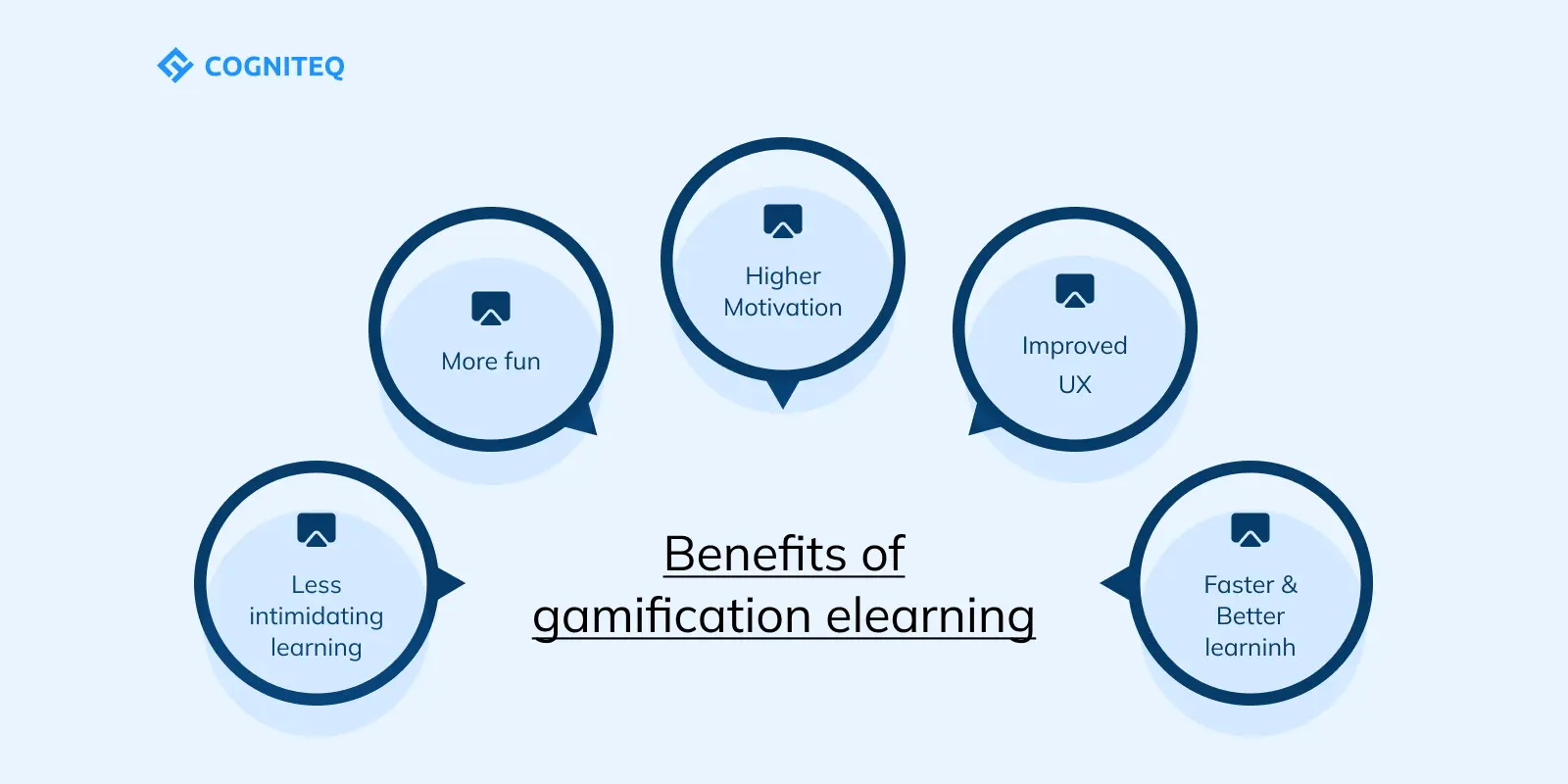

Suddenly, an idea struck him. What if he could transform the cybersecurity course into an immersive, game-like experience? He envisioned employees becoming digital detectives, solving cyber threats, and earning badges for their successes. The more he thought about it, the more excited he became about the possibilities of gamification in eLearning content development. eLearning content development.
Gamification has become a powerful tool in eLearning content development. It brings game-like elements into educational settings, making learning more engaging and fun. This approach has recently gained popularity, especially in corporate training and online education. Gamification improves knowledge retention by 40%, providing an interactive and enjoyable experience that fosters deeper learning.
Let's explore how gamification revolutionizes how we create and consume learning content.
Gamification in eLearning involves using game design elements in non-game contexts. This can include points, badges, leaderboards, and challenges. The goal is to make learning more enjoyable and motivating. By tapping into our natural desire for competition and achievement, gamification can significantly boost learner engagement and retention of information. The effectiveness of gamification lies in its ability to trigger positive emotions. When we play games, our brain releases dopamine, a feel-good neurotransmitter. This creates a sense of pleasure and motivation. By incorporating game elements into learning, we can make these psychological responses more appealing and rewarding for learners.

Gamification offers numerous benefits in the learning process. It increases motivation, improves engagement, enhances retention of information, and promotes a sense of achievement. Learners are more likely to complete courses and apply what they've learned when the content is presented in a game-like format. This approach also fosters a positive attitude towards learning.
Several elements make gamification effective in eLearning. These include points systems, badges for achievements, leaderboards for friendly competition, progress bars to track advancement, and levels or tiers to indicate mastery. Narratives or storylines can also be used to create a more immersive learning experience. These elements work together to create a compelling learning environment.
When developing interactive eLearning modules, it's crucial to integrate gamification by balancing learning objectives and designing game elements that support these goals. Consider your audience and choose appropriate game mechanics. For example, corporate training might use a point system tied to job performance metrics.
Visuals for eLearning play a significant role. We can tailor gamification. Use appealing graphics, animations, and interfaces to create an immersive game-like environment. Infographics can present information in a visually engaging way. Interactive elements like clickable objects or drag-and-drop exercises can enhance the learning experience and make it more game-like.
While it’s crucial to make learning more enjoyable, ensuring entertainment and education is essential. The game elements should enhance the learning experience, not distract from it. Ensure that the core content remains the focus, with gamification serving as a tool to engage learners and reinforce key concepts.
Personalization is a key trend in gamified eLearning. By tailoring the learning experience to individual preferences and skill levels, we can make the content more relevant and engaging. This might involve adaptive difficulty levels, personalized learning paths, or customizable avatars.
It's important to measure the effectiveness of gamification in eLearning to ensure its effectiveness. Track metrics such as completion rates, time spent on modules, and performance improvements. Gather feedback from learners about their experience with the gamified content. Use this data to refine and improve your gamification strategies over time.
While gamification offers many benefits, it also presents challenges. One common issue is over-gamification, where the focus shifts too much towards game elements at the expense of learning objectives. Another challenge is designing gamification that appeals to diverse learners. It's crucial to find the right balance and ensure that gamification supports rather than hinders learning.
AI in eLearning is playing an increasingly important role in gamification. AI can personalize the learning experience by adapting game elements to individual learner preferences and performance. It can also analyze large amounts of data to identify patterns and optimize gamification strategies. AI-powered chatbots can provide instant feedback and support within gamified learning environments.
We boosted Service Club's global workforce using mobile microlearning, revolutionizing training for Barcelona's HR-tech startup. Check out the case study here.
Corporate eLearning strategies often incorporate gamification to enhance employee training. Companies use leaderboards to foster friendly competition, badges to recognize achievements, and simulations to practice real-world scenarios. Gamified training can improve employee engagement, boost knowledge retention, and make mandatory training more enjoyable. It's particularly effective for onboarding new employees and teaching soft skills.

Language learning apps like Duolingo have successfully used gamification to make language acquisition more engaging. They use points, levels, and streaks to motivate users to practice daily. Short, game-like lessons make learning feel less daunting. This approach has helped millions of users stick with their language learning goals and achieve better results.
The adoption of gamified learning is on the rise, with the market projected to grow by over 27% by 2026. The future of gamification in eLearning is bright. We expect to see more innovative applications of game elements in educational content. Virtual reality (VR) and augmented reality (AR) technologies are also expected to play a significant role in creating more immersive gamified learning experiences.
When implementing gamification in eLearning, start with clear learning objectives. Choose game elements that support these objectives. Keep the user interface intuitive and engaging. Provide regular feedback and rewards to maintain motivation. Test your gamified content with a pilot group and be prepared to make adjustments based on user feedback.
Gamification pairs well with microlearning, which involves breaking content into small, easily digestible chunks. Short, game-like learning modules can be completed quickly, making them ideal for busy professionals. This combination can improve knowledge retention and make learning feel more manageable and enjoyable. Consider incorporating gamified microlearning into your eLearning strategy.
Storytelling can enhance the effectiveness of gamification in eLearning. By weaving content into a compelling narrative, you can create a more immersive and memorable learning experience. For example, a compliance training module could be presented as a detective story where learners solve ethical dilemmas. This approach can make even dry topics more engaging and relatable.

Effective gamification should cater to different learning styles. Visual learners might benefit from graphical representations of progress. Auditory learners could enjoy voice-overs and sound effects. Kinesthetic learners might appreciate interactive simulations. By incorporating elements that appeal to various learning styles, you can create more inclusive and effective gamified eLearning content.
Gamification can be combined with social learning to create a collaborative and competitive learning environment. Features like team challenges, peer-to-peer competitions, and social sharing of achievements can enhance engagement. This approach can be particularly effective in corporate settings, fostering teamwork and knowledge sharing among employees.
As we implement gamification in eLearning, it’s important to consider ethical implications. Ensure that competition doesn’t become overly stressful or demotivating for some learners. Be mindful of data privacy when tracking user behavior. Avoid manipulative practices that prioritize engagement over genuine learning. Strive to create a fair and inclusive gamified learning environment.
Gamification can make assessments more engaging and less stressful. Instead of traditional quizzes, consider using interactive challenges or simulations to test knowledge. Progress bars can show how close learners are to completing an assessment. Immediate feedback in a game-like format can make the assessment process more informative and less intimidating for learners.
Rewards play a crucial role in gamified eLearning. They can include virtual badges, points, or even real-world incentives. However, it’s important to design reward systems carefully. They should motivate learners without overshadowing the intrinsic value of learning. Consider using a mix of expected and surprise rewards to maintain engagement and excitement.
Gamification can be an effective tool for promoting continuous learning. By incorporating elements like daily challenges, streaks, and progressive difficulty levels, you can encourage learners to engage with content regularly. This approach is particularly valuable in rapidly changing fields where ongoing skill development is crucial. It can help create a culture of lifelong learning.
To justify investment in gamified eLearning, it’s important to measure its return on investment (ROI). Track metrics such as completion rates, knowledge retention, and performance improvements. Compare these to traditional learning methods. Also, indirect benefits like increased employee engagement and satisfaction should be considered. Use this data to refine your gamification strategy and demonstrate its value to stakeholders.
Gamification has revolutionized eLearning content development, making it more engaging, effective, and enjoyable. By incorporating game elements into learning experiences, we can tap into learners’ intrinsic motivation and enhance knowledge retention. As technology continues to evolve, the potential for gamification in eLearning will only grow, opening up exciting new possibilities for education and training.
LexiConn, a premier content writing agency in Mumbai, can be the perfect partner to revolutionize the eLearning experience. With their expertise in crafting engaging and informative content, LexiConn can help transform the dry cybersecurity course into an immersive learning adventure.
As a leading content writing service in the bustling heart of Mumbai, LexiConn brings a unique blend of creativity and technical knowledge to the table. Their skilled writers specialize in creating compelling eLearning content that captivates and educates simultaneously. They can develop engaging scenarios, quests, and narratives that turn complex cybersecurity concepts into exciting challenges for TechInnovate’s employees.
LexiConn’s writers are well-versed in gamification strategies and can seamlessly integrate game elements into the course material. They can craft reward systems, design achievement badges, and create leaderboard concepts that motivate learners to engage more deeply with the content.
Book a 30-minute complimentary session or drop us a line at [email protected].



I have read and accept the Privacy Policy
Read More